Lesson 31~32
✨课文
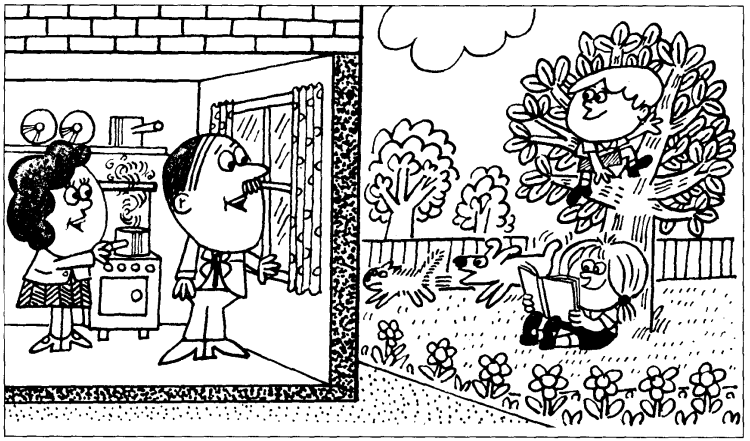
✨单词
现在进行时
⚡本课重点
时:动作发生的时间
态:动作的样子和状态
现在进行时:动作发生的时间是「现在」,动作的状态是「进行中」。核心结构是 am/is/are+V.ing,其中助动词be表示动作发生的时间,实义动词V.ing表示动作的状态。对应中文语境中的 正在做...
肯定句:表示现在正在进行或者发生的动作、状态。
主语+am/is/are+V.ing(+其他)e.g. He's reading a book.
否定句:只需在
be的后面加上not即可。主语+am/is/are+not+V.ing(+其他)e.g. He's not reading a book.
一般疑问句:只需将
be提到句首(主语前面)即可。Am/Is/Are+主语+V.ing(+其他)e.g. Is he reading a book?
特殊疑问句:在一般疑问句的句首加上特殊疑问词并去掉答案。
特殊疑问词+am/is/are+主语+V.ing(+其他)e.g. He's reading a book. => Is he reading a book? => What is he doing?
先把陈述句中的
be动词提到句首得到一般疑问句,再用what对一般疑问句中的答案reading a book进行提问,并将what提到句首
动词现在分词的规则变化
对于大多数动词来说,在动词后面直接加
-ing即可构成现在分词e.g. doing、climbing
以
-e结尾的动词,要去掉-e再加-inge.g. making、coming
如果动词只有一个元音字母,并且其后面跟了一个辅音字母时(往往以重读闭音节的形式出现,即
辅元辅),先双写词尾辅音字母再加-inge.g. running、sitting
现在进行时还能表示将来:某些非延续性动词的现在进行时可表示按计划、安排将要发生的动作,常见的有go、come、arrive、leave、start等
- e.g. They're getting married next month.、They're leaving for Beijing.
特殊疑问句的特殊情况:对主语提问时,直接用特殊疑问词替代主语即可
- e.g. Tim is climbing the tree. => Who is climbing the tree?
这个例子中,直接对主语Tim进行提问,用Who将其替代即可
Lesson 33~34
✨课文
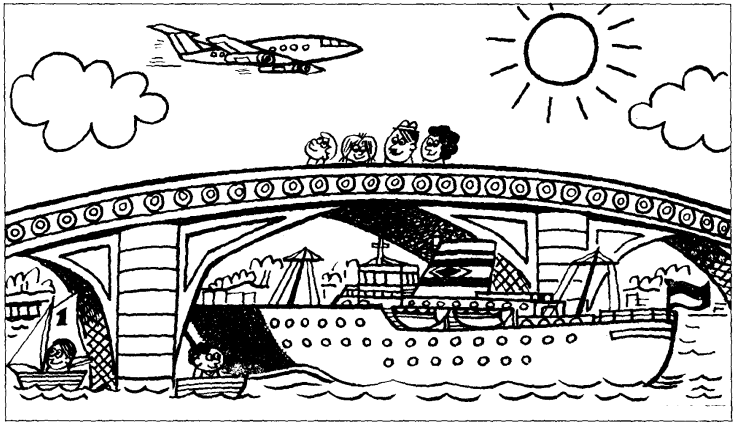
✨单词
⚡本课重点
在31~32课中学习了现在进行时的be单数形式,本节来学习其复数形式
当句中主语名词为复数、人称代词为第二人称或第三人称复数时,助动词be的现在时形式应为are
- e.g. They are walking over the bridge.
on和over的区别:它们都有「在...上面」的意思。但是on的关系双方之间需要直接接触表面,而over的关系双方可以不直接接触表面,常常用于表示悬浮在其上面
- e.g. There is a book on the desk.、The sky is over our heads.
ship和boat的区别:它们都是「船」的意思。但是ship表示的是在海洋中行驶的「大船」,而boat则是在河流中行驶的「小船」
Lesson 35~36
✨课文
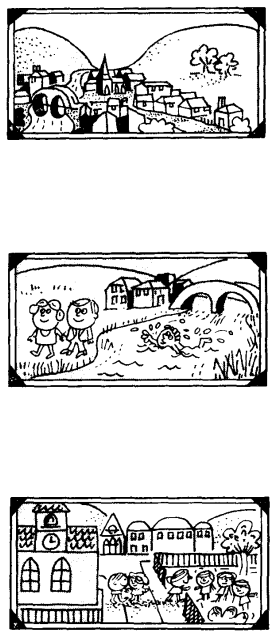
✨单词
⚡本课重点
动词短语:通常是指在动词的后面跟一个介词或副词短语形成的结构
结构:动词+介词/副词小品词
在英语中存在着一种用动词短语代替与其同义的单个动词的用法,这种用法称为「动词短语化」。例如听到敲门声,我们会说come in,而不会用enter来表达。最常见的动词短语是由英语中最短小和最简单的动词构成的,这些动词常与表示位置或方向的词组合,例如along、down、in、out、off、on、over、under等
不仅一个动词可以和大量的介词或副词小品词组合在一起构成动词短语,一个动词短语本身也可能有几种不同的意思
- e.g.
put on your coat、put it on
other和another
other+单数/复数another+单数
Lesson 37~38
✨课文

✨单词
一般将来时
⚡本课重点
一般将来时:动作发生的时间是「将来」,动作没有具体的状态(零状态)
本节课要学习的是 be+going to+V. 结构的一般将来时。在之后的91~92课中会学习 will/shall+V. 结构的一般将来时
当句中主语名词为复数、人称代词为第二人称或第三人称复数时,助动词be的现在时形式应为are。在口语中常常会用gonna替代going to
be going to表示将来
肯定句:
主语+am/is/are+going to+V.(+其他)表示打算、准备做某事
e.g. He is going to sleep.
表示按计划、安排要发生的事
e.g. The meeting is going to begin at nine.
表示预言一件事即将发生
e.g. It's going to rain.
否定句:只需在
be的后面加上not即可。主语+am/is/are+not+going to+V.(+其他)e.g. He is not going to sleep.
一般疑问句:只需将
be提到句首(主语前面)即可。Am/Is/Are+主语+going to+V.(+其他)e.g. Is he going to sleep?
特殊疑问句:在一般疑问句的句首加上特殊疑问词并去掉答案。
特殊疑问词+am/is/are+主语+going to+V.(+其他)e.g. He is going to sleep. => Is he going to sleep? => What is he going to do?
先把陈述句中的
be动词提到句首得到一般疑问句,再用what对一般疑问句中的答案sleep进行提问,并将what提到句首
宾语补足语:对宾语进行补充说明,动词+代词(名词)+形容词
- e.g. Paint the bookcase pink.
及物动词:本身词义不完整,后面必须跟宾语
不及物动词:本身词义完整,后面不需要跟宾语。如果要跟宾语,则动词后面要加介词之后才可以跟宾语
paint it连读:发音类似/peintit/,it要失去爆破
Lesson 39~40
✨课文

✨单词
⚡本课重点
祈使句否定形式:在动词原形前面加上Don't或Do not即可,结构为 Don't(Do not)+V.+名词(代词)。相关概念和肯定句式参考之前的3~4课
- e.g.
Don't do it
双宾语:相关概念参考之前的23~24课,本节课主要讲的是其give sth. to sb.的形式
动词+介词的词组,如果再加名词的话,可以放中间也可以放后面。而如果是代词的话,只能放中间
give it连读:发音类似/givit/,it要失去爆破
put it连读:发音类似/pʊtit/,it要失去爆破
drop it连读:发音类似/drɒpit/,it要失去爆破
front of连读:发音类似/frʌntof/,of夺取front中的t发音,it要失去爆破
Lesson 41~42
✨课文

✨单词
⚡本课重点
不可数名词:不可数名词的前面不能加a或an,也没有复数形式,也就是说前面不能加常规的数量词。如果想表示「一些」,可以用some或any等特定的词
如果想表示量的概念时,要用某种「容器」承载不可数名词,然后就可以对其使用常规数量词来描述了
e.g. Two bottles of milk.
There be结构中使用可数名词和不可数名词:当There be后面跟单数名词或不可数名词时,be要用is;而当后面跟复数名词时,be要用are。There be后面的名词是句子的主语
There is+名词单数/不可数名词(+地点(时间)状语)e.g. There's some milk.
There are+可数名词复数(+地点(时间)状语)e.g. There're two books on the table.
如果后面跟多个并列的名词时,
be的形式以第一个名词为准,即所谓的「就近原则」e.g. There's a pen, two books and a knife on the table.
Lesson 43~44
✨课文

✨单词
情态动词can
⚡本课重点
情态动词can:单词本义为「能」。它本身不表示动作,只表示体力和脑力方面的能力或客观可能,它必须与其他东西连用,没有人称和数的变化
肯定句:表示能力或可能。
主语+can+V.(+其他)e.g. The bird can fly in the sky.
否定句:只需在
can的后面加上not即可。主语+can+not+V.(+其他)e.g. The dog can not fly in the sky.
一般疑问句:只需将
can提到句首(主语前面)即可。Can+主语+V.(+其他)e.g. Can the bird fly in the sky?
特殊疑问句:在一般疑问句的句首加上特殊疑问词并去掉答案。
特殊疑问词+can+主语+V.(+其他)e.g. The bird can fly in the sky. => Can the bird fly in the sky? => What can the bird do?
先把陈述句中的
can提到句首得到一般疑问句,再用what对一般疑问句中的答案fly in the sky进行提问,并将what提到句首
find it连读:发音类似/faɪndit/,it要失去爆破
Lesson 45~46
✨课文

✨单词
⚡本课重点
can的否定特殊疑问句:在can的后面加上not即可,结构为 特殊疑问词+can't+主语+V.(+其他)
- e.g. Can Pamela read the letter? => Why can't Pamela read the letter?
read it连读:发音类似/redit/,it要失去爆破
ask sb. to do sth.:请求某人做某事
Lesson 47~48
✨课文

✨单词
一般现在时
⚡本课重点
一般现在时:动作发生的时间可以是「过去、现在、将来」,动作没有具体的状态(零状态)
在本节课之前见过的各种 主语+am/is/are+名词/形容词 句式其实就是「主系表结构」的一般现在时,这种句式的谓语是助动词be
表示客观事实或存在状态
e.g. It's very hot today.
而本节课则主要学习其「主谓宾结构」的一般现在时非三单形式,核心结构是 主语+V.,它的谓语是实义动词。而其三单形式可以看之后的49~50课
一般现在时非三单形式
肯定句:实义动词的前面其实有个隐式的
do,只是肯定句中经常省略而已。主语(+do)+V.(+其他)e.g. I want this job.、I do like tea.
否定句:显式使用
do并在后面加上not即可。主语+do not+V.(+其他)e.g. I do not want this job.、I don't like tea.
一般疑问句:显式使用
do并将其提到句首(主语前面)即可。Do+主语+V.(+其他)e.g. Do you want this job?
特殊疑问句:在一般疑问句的句首加上特殊疑问词并去掉答案。
特殊疑问词+do+主语+V.(+其他)e.g. I want this job. => Do you want this job? => What do you want?
先把陈述句中的
do提到句首得到一般疑问句,再用what对一般疑问句中的答案this job进行提问,并将what提到句首
一般现在时还有如下两种常见用法
- 表示习惯或反复的动作
e.g. She gets up at 7 o'clock every day.
- 表示将来。主要用于时间、条件让步状语从句中,或表示按时间表、安排等到某时间就发生的事情或动作
e.g. The train leaves London at six and arrives in Birmingham at eight.
love him连读:发音类似/lʌvɪm/,him出现发音击穿现象(语音变音),h不发音
Lesson 49~50
✨课文

✨单词
动词三单变化
⚡本课重点
在47~48课中学习的主要是「主谓宾结构」的一般现在时非三单形式,而本节课则主要学习其三单形式
一般现在时三单形式
do的第三人称单数为does
肯定句:当
does隐藏时,实义动词要用第三人称单数形式;显式使用does的时候,实义动词要用原形。主语(+does)+V.s/es(+其他)e.g. He wants this job.、She does like tea.
否定句:显式使用
does并在后面加上not即可。主语+does not+V.(+其他)e.g. He does not want this job.、She doesn't like tea.
一般疑问句:显式使用
does并将其提到句首(主语前面)即可。Does+主语+V.(+其他)e.g. Does he want this job?
特殊疑问句:在一般疑问句的句首加上特殊疑问词并去掉答案。
特殊疑问词+does+主语+V.(+其他)e.g. He wants this job. => Does he want this job? => What does he want?
先把陈述句中的
does提到句首得到一般疑问句,再用what对一般疑问句中的答案this job进行提问,并将what提到句首
动词第三人称单数的变化:一般现在时中,当主语是第三人称单数时,实义动词要用第三人称单数形式
①一般情况下在词尾直接加
se.g. want => wants
②以辅音字母加
y结尾的动词,将y改为i,再加-es,读/z/e.g. fly => flies、cry => cries
③以元音字母加
y结尾的动词,在词尾直接加-s,读/z/e.g. play => plays
④以字母
s、x、o、z、ch、sh结尾的动词,这词尾直接加-es,读/iz/e.g. go => goes、watch => watches
⑤不规则变化
e.g. have => has
Lesson 51~52
✨课文
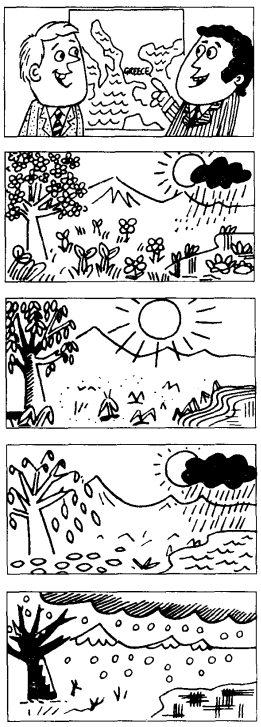
✨单词
⚡本课重点
what...like:用来询问事物的状况,或询问人物、事物的外观、特征
e.g. What's the weather like today?、What's your house like?
how often:常用于对某事、动作发生的频率进行提问
e.g. How often do you go to the cinema?
频率副词:always > often > usually > sometimes > never
- 在句子中用于
be动词之后 - 用在实义动词之前
- 如果是否定句或疑问句,用在助动词和实义动词之间
- 为表示强调,频率副词可以放在句首或句尾
Lesson 53~54
✨课文
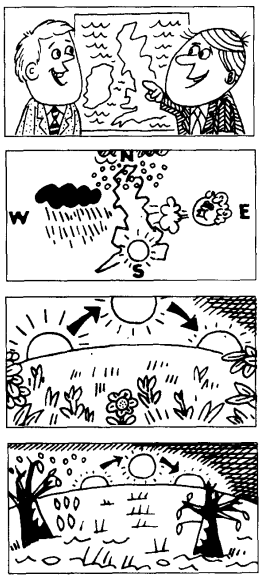
✨单词
⚡本课重点
like的不同词性
当其做动词时表示「喜欢、想要」
e.g. I like that sweet girl.
当其做介词时表示「怎么样、像...一样」
e.g. His car is like mine.
当其做形容词时表示「类似的、相似的」
Lesson 55~56
✨课文

✨单词
⚡本课重点
本节课主要还是围绕着一般现在时进行展开,只是着重使用一般现在时来表示某种习惯的、反复的动作
e.g. In the morning, Mr. Sawyer goes to work and the children go to school.
take sb. to somewhere:带某人去某处
e.g. Their father takes them to school every day.
Lesson 57~58
✨课文
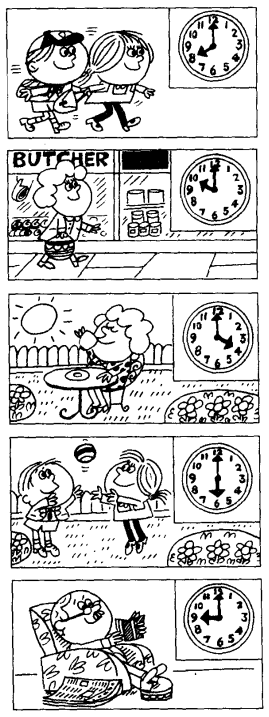
✨单词
时间的表达方式
⚡本课重点
时间的表达方式
通用表达
e.g. six o'clock => 6点整、ten ten => 10点10分、twelve forty => 12点40分
分 past 时:表示「某个整点时间过去了多少分钟」,这种方式要求当前的自然分钟数必须
小于等于30e.g. half past six => 6点半、a quarter past ten => 10点15分、five past twelve => 12点5分
分 to 时:表示「距离某个整点时间还差多少分钟」,这种方式要求当前的自然分钟数必须
大于30e.g. ten to seven => 6点50分、a quarter to eleven => 10点45分
在口语环境中,当谈话双方对当前的时间都有个大致的掌握时,可以省略掉介词
to。例如:差15分钟就1点 =>quarter one
一般现在时与现在进行时
一般现在时表达「习惯或反复的动作」时,通常与时间频率副词连用
e.g.
always、often、usually、sometimes、never现在进行时表达「此刻正在进行的事情或动作」时,通常与时间状语连用
e.g.
now、at the moment、today、this morning、tonight等
Lesson 59~60
✨课文

✨单词
have用法①
⚡本课重点
have用法①:单词本义为「有、拥有」。它作为动词时有第三人称单数形式has,当它表示「有」这个概念时,其否定形式和疑问形式各有两种。
否定句:可以在
have/has后面直接加not,也可以用助动词do/does的否定形式。have not=haven't,has not=hasn't- e.g. I have a car. => I haven't a car. => I don't have a car.
- e.g. He has a car. => He hasn't a car. => He doesn't have a car.
一般疑问句:将
have/has提到句首(主语前面),或者用助动词do/does- e.g. Have you a car? => Do you have a car?
- e.g. Has he a car? => Does he have a car?
have的另外三种用法参考61~62课、81~82课和87~88课
else:常常跟在疑问代词、不定代词、疑问副词的后面
e.g. What else do you want?、Who else is from Japan?
Lesson 61~62
✨课文

✨单词
have用法②
⚡本课重点
have用法②:常常与表示疼痛和疾病的名词连用。不定冠词a/an与这类名词连用时,分以下几种情况
必须用不定冠词的情况:
a cold、a headache、a sore throate.g. I have a cold.、I have a headache.
不定冠词用或不用都行:
catch (a) cold、have (a) backache/toothache/stomach achee.g. I've had toothache all night.
复数形式的疾病名称前面不用冠词:
measles、mumps、shinglese.g. Most children are in bed with mumps.
被认为不可数的疾病名词前面不用冠词:
flu、gout、hepatitis等e.g. I was in bed with flu for ten days.
the也可以跟flu、measles、mumps等词连用e.g. He's got the flu.
Lesson 63~64
✨课文
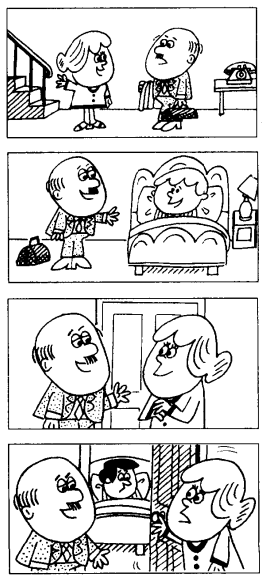
✨单词
⚡本课重点
must:参考之前的29~30课
so
作为程度副词时,用于形容词或副词的前面,表示「如此」
e.g. She is so beautiful.
作为转折连词时,表示「因此」
e.g. You have flu so you must stay at home.
because:单词本义为「因为」,它和so之间的关系如下
用了因为就不能用所以,用了所以就不能用因为
e.g. You must stay at home because you have flu. => You have flu so you must stay at home.
wake up:表示「醒来」
get up:表示「起床」
Lesson 65~66
✨课文

✨单词
⚡本课重点
反身代词:关于各人称代词所对应的反身代词,可以参考基础概念中的人称代词
当宾语和主语是同一个人时,一般需要用反身代词
e.g. The old lady is talking to herself.
反身代词也可以和名词连用,表达「就是那个人而不是别人」
e.g. They wanted to finish the work themselves.
dad和mum:它们前面如果没有「所有格代词」或「名词所有格」作修饰的话,就特指自己的父母,此时要大写开头
this、next、every等词开头的时间状语前面通常不加介词
want to do sth.:想要做某事
keep up with sb.:赶上某人
keep on doing sth.:继续保持做某事
cost和pay
- cost:物做主语,表示「某物的售价」
- pay:人做主语,表示「人为某物付钱」